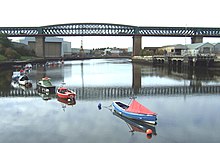Queen Alexandra Bridge
| Queen Alexandra Bridge | |
|---|---|

The Queen Alexandra Bridge in October 2007.
|
|
| Carries | Motor vehicles (A1231 road) Pedestrians |
| Crosses | River Wear |
| Locale | Sunderland, England |
| Characteristics | |
| Design | Truss bridge |
| Longest span | 300ft |
| Clearance below | 85ft |
| History | |
| Opened | 1909 |
The Queen Alexandra Bridge is a road traffic, pedestrian and (former) rail bridge spanning the River Wear in North East England, linking the Deptford and Southwick areas of Sunderland. The steel truss bridge was designed by Charles A. Harrison (a nephew of Robert Stephenson's assistant). It was built by Sir William Arrol between 1907 and 1909 and officially opened by The Earl of Durham, on behalf of Queen Alexandra on June 10, 1909.
In 1899 the North Eastern Railway and the Sunderland Corporation agreed to build the bridge to improve communications across the river and to connect the coalfields of Annfield Plain and Washington with Sunderland's south docks. Before the completion of the bridge, road traffic crossing the river had to use one of two ferries which crossed below near to where the bridge is today. As the bridge was due to be built near to the successful shipyards of the Wear, a clause in the North Eastern Railway Act 1900 required that only one arch span be built over the river to give a clearance of 85 feet above high water level.
The approaches to the bridge were completed in 1907 by the Mitchell Brothers of Glasgow and the bridge proper comprises three 200 foot land spans (weighing 1,000 tons of steel each) and a 300-foot river span (weighing 2,600 tons of steel) and was the heaviest bridge in the United Kingdom at the time. The bridge was built from each side of the river and the two halves came together at noon on 15 October 1908. In all, a total of 8,500 tons of steel, 4,500 tons of granite, 60,000 tons of red sandstone from Dumfries, and 350,000 bricks were used and the cost of completion was £450,000. The bridge also housed gas and water mains and in later years, high voltage electricity cables and a pumped rising-main for sewage.
...
Wikipedia
